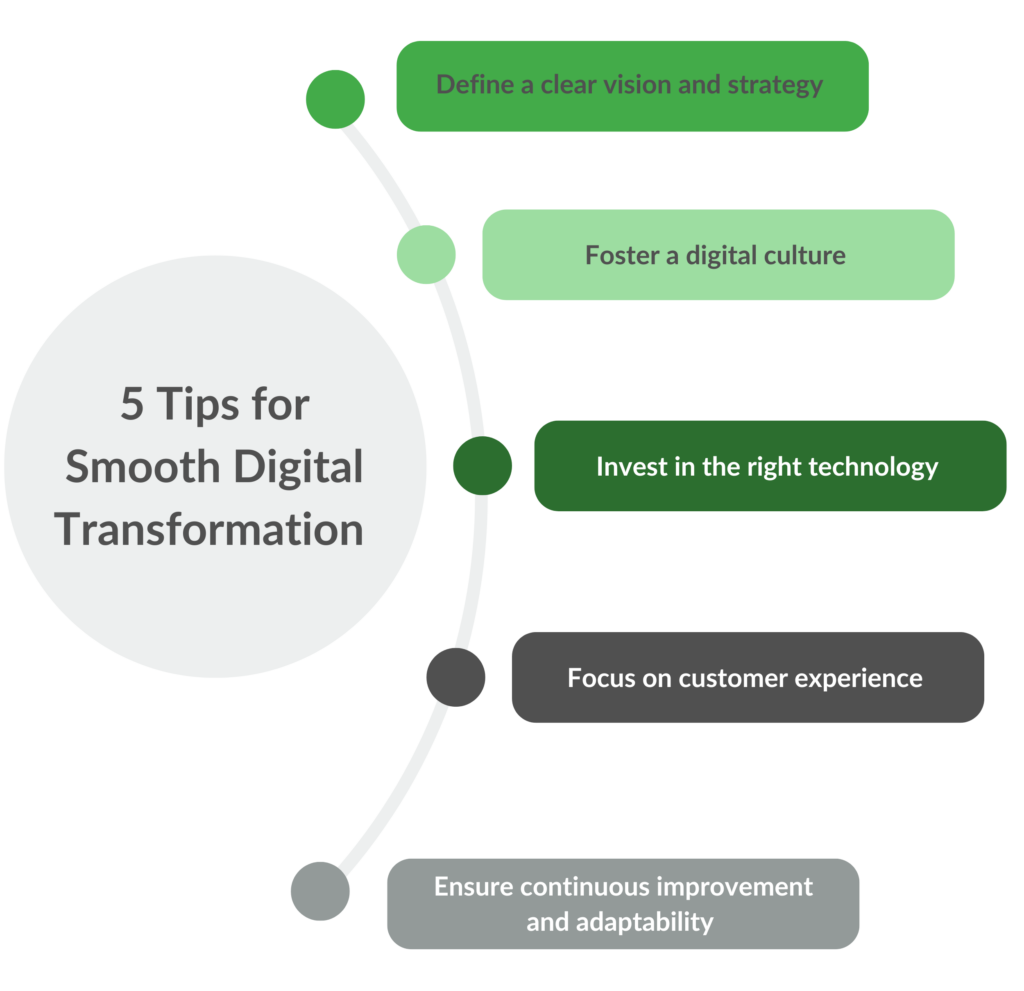5 Digital Transformation Tips – Make This Business Process Smooth

Introduction
In today’s fast-paced business environment, digital transformation has become a crucial component for maintaining competitiveness and relevance. Digital transformation involves leveraging technology to fundamentally change how businesses operate and deliver value to employees and customers. It’s more than just adopting new tools; it’s about rethinking business processes, culture, and customer interactions to align with a digital-first approach.
The importance of digital transformation cannot be overstated. As technology evolves and end user expectations shift, businesses must adapt to stay ahead. A well-executed digital transformation strategy helps companies improve efficiency, enhance customer experiences, and drive innovation. Here are five essential tips to make your digital transformation process smooth and effective.
1. Define a Clear Vision and Strategy
Having a clear vision and strategy is the cornerstone of a successful digital transformation. Without a well-defined direction, digital initiatives can become disjointed and ineffective.
Creating a Digital Transformation Roadmap:
Start by outlining your long-term vision for digital transformation. This vision should be aligned with your overall business objectives and should provide a clear picture of what success looks like.
Setting Specific Goals:
Establish specific, measurable, achievable, relevant, and time-bound (SMART) goals for your digital transformation efforts. These goals will guide your strategy and help track progress.
Aligning Digital Initiatives with Business Objectives:
Ensure that your digital initiatives are directly aligned with your business objectives. This alignment helps in achieving a cohesive approach where every digital effort contributes to overarching business goals.
2. Foster a Digital Culture
A strong digital culture is vital for successful digital transformation. It involves cultivating an environment that embraces change, innovation, and continuous learning.
Encouraging Innovation and Creativity:
Promote a culture where innovation is encouraged. This can be achieved by supporting experimental projects, allowing employees to take calculated risks, and celebrating creative solutions.
Providing Continuous Learning and Development Opportunities:
Invest in training and development programs to equip your employees with the skills needed for digital transformation. Continuous learning helps in keeping up with technological advancements and industry trends.
Promoting Collaboration and Communication:
Facilitate open communication and collaboration across departments. Digital transformation often requires cross-functional teamwork, and effective collaboration can lead to more innovative solutions and efficient problem-solving.
3. Invest in the Right Technology
Choosing the right technology is crucial for achieving your digital transformation goals. The right tools can drive efficiency, enhance capabilities, and provide a competitive edge.
Key Technologies to Consider:
Cloud Computing: Offers scalability, flexibility, and cost-efficiency. Cloud solutions enable remote work and access to data and applications from anywhere.
Artificial Intelligence and Machine Learning: These technologies can automate processes, provide insights through data analysis, and enhance decision-making.
Internet of Things (IoT): IoT devices can provide real-time data and enhance operational efficiency by connecting various systems and devices.
Cybersecurity Solutions: Ensuring robust cybersecurity is essential to protect your digital assets and maintain customer trust.
Tips for Evaluating and Selecting Technology Vendors:
When selecting technology vendors, consider factors such as vendor reputation, technology compatibility, support services, and scalability. Evaluate vendors through demonstrations, client references, and trial periods to ensure their solutions meet your needs.

4. Focus on Customer Experience
Enhancing customer experience is a key driver of digital transformation. A positive and personalized experience can lead to increased customer satisfaction and loyalty.
Strategies to Enhance Customer Experience:
Utilizing Customer Feedback: Regularly gather and analyze customer feedback to understand their needs and preferences. Use this data to make informed decisions and improvements.
Personalizing Customer Interactions: Leverage data and analytics to tailor interactions and recommendations based on individual customer preferences and behaviors.
Streamlining Customer Journeys: Simplify and optimize customer interactions across all touchpoints. Ensure that processes are intuitive and that customers can easily achieve their goals.
Tools and Technologies to Improve Customer Experience:
Consider implementing customer relationship management (CRM) systems, chatbots, and analytics tools to enhance and manage customer interactions effectively.
5. Ensure Continuous Improvement and Adaptability
Digital transformation is not a one-time project but an ongoing journey. Ensuring continuous improvement and adaptability is key to sustaining long-term success.
Methods to Ensure Ongoing Optimization:
Regularly Reviewing and Updating Digital Strategies: Continuously assess your digital strategies to ensure they remain relevant and effective. Make adjustments based on performance metrics and changing business needs.
Measuring and Analyzing Performance Metrics: Track and analyze key performance indicators (KPIs) to evaluate the success of your digital transformation initiatives. Use insights to drive improvements and address any issues.
Staying Adaptable to Market Changes and Technological Advancements: Remain flexible and open to change. Stay informed about industry trends and technological advancements to adapt your strategies and stay competitive.
Tips for Fostering a Culture of Continuous Improvement:
Encourage a mindset of ongoing improvement by recognizing and rewarding innovation, soliciting feedback, and fostering a proactive approach to problem-solving.
Conclusion
To achieve a smooth digital transformation process, it is essential to define a clear vision and strategy, foster a digital culture, invest in the right technology, focus on customer experience, and ensure continuous improvement. By following these tips, businesses can navigate the complexities of digital transformation effectively and reap its benefits.
Ready to embark on your digital transformation journey? Start with these tips to guide your process or contact Plow Networks for consulting to help you tailor a strategy that fits your specific needs.
Explore more on:


